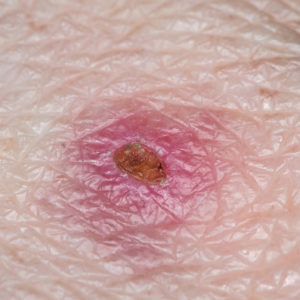Your cart is currently empty!
Playlist includes 6 training videos
Our growing quest for outdoor adventures often leads to injury and illness as a result of specific factors related to the environment that frequently require first aid care.
Insect bites and stings are a common and annoying occurrence. Most bites are minor but the potential for a serious allergic reaction does exist.
Be alert for any signs or symptoms of a severe allergic reaction, as this must prompt immediate 911/EMS notification.
Bites and stings caused by insects such as spiders, scorpions, and fire ants can cause local reactions (Figure 12a), but on occasion more serious systemic reactions can occur.

The black widow spider bite is known to cause severe abdominal pain that can mimic appendicitis in children.
Ticks carry a variety of diseases, and one must be vigilant for signs and symptoms for up to one month after exposure. Signs of a tick-borne disease include fever, headache, joint pain, and skin rash. To remove an attached tick, grasp it by the head with tweezers and pull straight out. Clean the area with soap and water or an alcohol swab. If the tick bite occurred in a geographic area where tick-borne disease occurs, seek medical treatment for possible prophylactic antibiotic therapy.

Lyme disease can produce a distinctive “bull’s eye” rash (Figure 12b). Seek medical treatment.
If visible, remove a bee stinger by scraping it away. Wash the area with cold water and apply ice. Stay with the person for at least 30 minutes as some allergic reactions can be delayed in onset.
A bite from an animal such as a raccoon, bat, skunk, fox, or coyote carries the highest risk of rabies. Always make sure the scene is safe when giving first aid to any person with an animal bite. Contact the emergency response system as an animal control officer may be able to capture the animal and determine the risk of rabies. Clean the wound with soap and water and control bleeding by applying direct pressure. Animal bites are prone to infection and can cause further injury due to the puncture nature of the wound. Seek medical care by a qualified health care professional for any bite that breaks the skin, or if there is concern about rabies or other infection.
Snakebites require medical attention. If the pain is getting worse, swelling occurs, bruising develops, or systemic signs (nausea and vomiting) develop, a venomous snakebite has occurred. Call 911/EMS and do not delay medical attention. Make sure the scene is safe, and the snake is no longer a threat. Keep the person calm and try to avoid moving the extremity that was bitten. Remove any constricting clothing and jewelry from the affected area. Gently wash the affected area with soap and water if available. Additional care is required in a hospital setting. Do not apply a tourniquet.
Heat-related illnesses can occur due to extremes of temperature, particularly in the elderly, and during vigorous exercise. Illnesses include heat cramps, heat exhaustion, and heatstroke.
Heat cramps result in painful muscle spasms of the extremities, the back, and the stomach. Sweating and headache may accompany the cramps. Symptoms most often resolve with resting, cooling-off, and drinking water, a sports drink, or a similar electrolyte solution. Light stretching and massage can also be helpful.
Heat exhaustion is more serious. Signs of heat exhaustion include dizziness, vomiting, muscle cramps, fatigue, increased sweating, and lightheadedness.
Immediately move the person to a cooler environment if possible. Have the person lie down and loosen or remove as much clothing as possible. Use cool water to spray them and fan if available. A cool damp cloth can be used as an alternative. Encourage them to drink water or a sports drink. Remain with them until the emergency medical response arrives.
Heatstroke is life-threatening, and immediate action is required. Signs and symptoms of heatstroke include confusion, loss of consciousness, dizziness, muscle cramps, vomiting, and seizures. If you think the person is having a heatstroke, immediately call 911/EMS.
Exposure to the UV radiation from sunlight can result in sunburn. Sunburn can be minor or result in blistering and sloughing (Figure13) of skin.
Exposure to cold can result in frostbite and is most common in extremities such as ears, nose, fingers, and toes. Wind chill increases the risk of frostbite. In severe frostbite cases, ice crystals form in the tissues and destroy cells resulting in permanent damage. The skin will appear waxy and white or yellow-gray. The area will be cold and numb and may feel like a block of wood. The tissue will be firm and will not move or compress easily when squeezed.

Do not rub, squeeze, or slap the affected extremity as this may increase tissue damage. Do not rewarm a frozen extremity if there is a risk of refreezing. Seek further care from a health care professional.
Hypothermia is a potentially life-threatening condition when the body temperature falls dangerously low. Hypothermia can even develop in non-freezing temperatures.
Rapid action is required to care for a hypothermic person.
The list of toxins and potential poison exposure is extensive and beyond the scope of this handbook. Some basic concepts that are universally applicable for first aid providers are included in this handbook.
A material safety data sheet (MSDS) is required to be available where chemicals are in use in businesses and institutions. The data sheets provide information about the composition of various chemicals and are useful when contacting poison control.
When treating any toxin and poison exposures, the eyes should be flushed with copious amounts of water. Acids and alkaline solutions are particularly caustic and can lead to permanent vision impairments or loss.